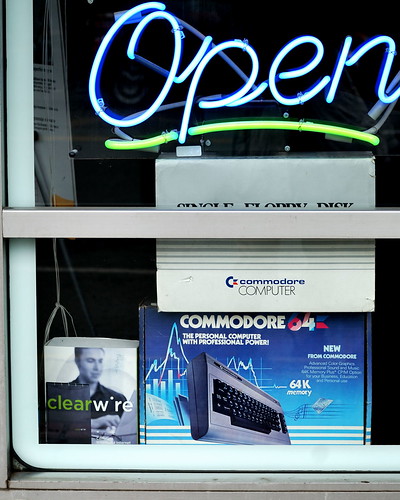 |
status privacy about contact |
|
|
Welcome to Orcmid's Lair, the playground for family connections, pastimes, and scholarly vocation -- the collected professional and recreational work of Dennis E. Hamilton
Archives

Atom Feed Associated Blogs Recent Items |
2009-05-03Saturday Geek Photo: A Back-to-the-Future Moment
When I happened to glance into this window of the neighborhood computer store, I had a sudden back-to-the-future moment. I had to check my surroundings to ensure that I hadn’t step through a time warp. I don’t have any explanation for this being here, and I didn’t step inside to ask. I did have my camera along. As I look around me today, it is difficult to recall how exciting these machines and their brethren were for us. Despite their considerable limitations, they inspired the imagination in ways that won’t occur in that way again. The original Commodore Business Machine (CBM) was an all-in-one unit that resembled some sort of Aztec pyramid with its monitor on top. I remember checking them out around 1977. I was concerned enough about the cost of service and maintenance for those and similar units that I spent the months before my first microcomputer going through the Heathkit courses on DC and AC Electronics while building my own instruments, starting with a multi-meter and culminating with an oscilloscope. Having done that, I ordered my first H8 computer and rapidly assembled that, the matching floppy-disk units, the H19 terminal, and then an H89 all-in-one computer, starting in 1978. Although I was a Z80 Assembler and CP/M-80 hold-out, the microcomputer era ended for me when I purchased an assembled Heath-Zenith Z158 PC XT clone. Although the Z158 sported the original MS-DOS 64k RAM and Intel 8088 processor, I recall adding a memory-expansion board, additional hard disk (on an add-in board), and Microsoft Windows 1.03. I managed to keep Windows on it all the way through 3.0. My use of Windows was primarily as a shell for the basic Windows utilities and MS-DOS programs, including Microsoft Works, and Turbo Pascal. Nothing stressed Windows much and the result was tolerable performance on my underpowered system. I had an early version of the Windows SDK as well. My favorite text editor was the Microsoft Editor that was packaged with Microsoft development tools at that time. I wasn’t particularly thrilled with the command-line C compiler, having far more affection for Borland’s Turbo C and, later, Turbo C++. And, in a side room, there was also an Atari 800. Although the 8-bit Atari was kept mainly as a recreational machine with limited floppy-disk capacity, I was inspired to publish an article on fractal dragon curves [Compute! October 1986, pp. 78-89] that exploited the relationship of dragon curve-walking to carry propagation in a binary counter. Labels: Golden Geek Comments: Post a Comment |
|

|
You are navigating Orcmid's Lair. |
template
created 2002-10-28-07:25 -0800 (pst)
by orcmid |
